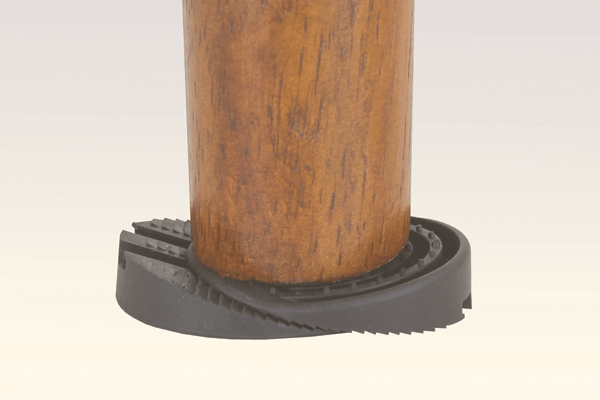You have friends and family over at your place. Someone mistakenly touches the center table, and all snacks litter the ground. They feel guilty, but you know they’re not the real culprit. Your uneven floor is! Having an uneven floor can cause many embarrassing problems, one of which is leaving your furniture wobbly and unstable.
Apart from leaving your guests stunned, it could also be dangerous for those who have kids. However, if you’re not looking to fix the root of the problem, there are a few short-term fixes that could help make the uneven floors less of a problem.
Methods you can use include shims, furniture coasters, adjusting the limbs (applicable with adjustable furniture), or using furniture levelers. Try one of these, and your furniture problem should be fixed in no time. This article will explain each of these methods in detail and the pros and cons.

You May Like
How to Fix Squeaky Hardwood Floors
Do Rug Pads Damage Hardwood Floors
What Causes Squeaky Floors under Carpet
Contents
Methods used in Leveling Furniture on Uneven Floors
1. Using Shims
Shims are wooden or plastic pads used in supporting furniture on uneven floors. In most cases, shims are shaped like wedges, serving as elevated support for furniture on the wobbly part. Shims are easy to use in that they do not require any technicality to use. You could also use shims that match the color of your furniture to mask them.

To use a shim, here are the steps involved:
- First, determine the legs of your furniture, which are wobbly. You can tip the furniture to see which leg hangs off the floor. You could also place a level on top of the furniture. The fluid in the middle section of the level will have a bubble, which floats towards the higher furniture part, making it easier to know which part of the furniture is sloped.
- Slide the shims under the furniture’s legs. Lift the furniture legs and slide in the shims. Slide in the base part of the wedge first. While the shims are easy to use, you’ll have to reinstall them each time you move the furniture. Hence, it is advisable to use them for furniture which doesn’t change position frequently. You could also glue the shim to the ground if you don’t mind the effect on your flooring.
- Stack as many shims until the furniture is level. Some furniture might require more than one shim. However, if you’re big on aesthetics, you might want to use a concealing fix.
Note: There are also wooden or plastic shims. If you’re using the shims in a damp area, the plastic shims are more suitable.
- Cut off the part of the shim sticking out. If you want the shims to be concealed as much as possible, you can break off the part sticking out. Just yank the piece sticking out until it breaks off. However, you can do this for wooden shims only.
Pros
- It’s easy to use.
- It is an affordable option.
- It can be easily concealed.
Cons
- It will require constant reinstallation if you move your furniture frequently.
- It could damage your flooring if glued to the ground.
- It could look out of place if you use stacks of shims.
2. Adjust the Limbs (For Adjustable Furniture)
Some furniture pieces have limbs that can be adjusted to the furniture’s height. These furniture pieces are the best type to use in a house with an uneven floor. Their adjustment is quite easy, and you don’t need to spend anything to fix this.
For adjustable furniture, here are the steps involved:
- Determine the unbalanced side of the furniture. You can do this by simply tipping or using a level as explained above.
- Check the type of adjustable limbs on the furniture. Some types have slot holes where you can loosen or tighten the whole limb. These slot holes are usually placed below the bottom drawer, directly above the limbs. Some have adjustable attachments on the limbs, which can be adjusted to increase or decrease the height of the furniture.
- For slot holes, remove drawers and adjust. If your furniture uses a slot hole, remove the drawers and adjust the limbs using a flat head screwdriver. Turn it clockwise to lower the furniture and vice versa.
- For adjustable ends, simply adjust them with your hands. The adjustable attachments on the limb just need to be adjusted with your hands to the required height.
- You could also install this on your furniture. You could also try to install adjustable legs on your furniture; however, this might be expensive as you’ll require the services of a professional.
Pros
- You don’t need to spend a dime.
- It is very easy to use.
Cons
- To install adjustable feet on ready-made furniture is expensive.
3. Using Furniture Coasters
Furniture coasters work just the same as shims. The only difference is there are not wedged. However, they come only in rubber forms and are not wedged. This gives them a better grip on the floor than wooden shims. Also, they’re easy to remove and reuse. However, this could be an advantage and disadvantage in itself.
If you’re using furniture that has to be moved constantly, then the coasters have to be reinstalled too. However, it shouldn’t be much of a fuss if the furniture isn’t too heavy. However, since they do not come in wedges, you’ll have to stack several coasters if one isn’t sufficient. This is a disadvantage compared to the shim, which gives different elevation levels just with one shim. A quick fix to this will be to place the coasters under a rig and then place the imbalance leg on the shim.
Coasters are installed the same way as shims.
Pros
- Easy to install and reuse.
- Affordable to install.
Cons
- Requires constant reinstallation if you have to move the furniture frequently.
- It might require multiple coasters, which affect aesthetics.
4. Using Furniture Levellers
This is one of the most concealing options to use in leveling furniture. It can also serve as a long-term fix to your imbalance furniture problems. They’re also adjustable, so you can adjust the height if you have to move the furniture to another spot. However, this might not be preferable with expensive furniture or antiques. This is because you have to drill holes in the furniture.
To install furniture levelers, follow these steps:
- Purchase premade furniture levelers. Although you could get it made, this is the easiest option, and they’re cheap. You could also purchase nail-on glides.
- Drill holes into the furniture limbs. You might want to get a professional to do this if you’re not familiar with using a drill. If you are, use a power drill and a drill bit with the same diameter as the inserts to make the holes.
- Put the insert into the drilled hole. These inserts usually come in two parts: the insert and the circular pad jointed with a screw. Put the insert into the drilled hole and then screw in the circular pad. If you’re using the nail-on glides, simply insert them into the holes, and they’re good to go.
- Adjust the screwed pad to the desired height. You can adjust the screw to the desired height. The circular pads always come with a felt or plastic part to prevent scratching the floor. However, you must ensure the felt isn’t wearing off to avoid damaging your floor.
Pros
- It fits in well with the furniture.
- It is easily adjustable.
- It is a long-term fix.
Cons
- It might not be preferred with antiques and expensive furniture.
- It could scratch your flooring.
- Requires a professional (could be a DIY project too).
Conclusion
With any of these methods, your imbalanced furniture on uneven floors becomes a thing of the past. Now, you can invite guests to your home without worrying about someone’s head getting accustomed to the floor texture, thanks to the wobbly chair.
